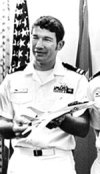mpdonnelly
Registered User
The FM-2/F4F Wildcat had a landing gear system that required the pilot to hand crank it into position (think T-34 manual gear extension, particularly about the notes/warnings/cautions). Some enterprising pilots figured a way to speed the process by unlocking the system and then pulling a hi-G turn to fling the gear into place. As one might imagine, the gear handle in the cockpit spun and it wasn't unusual to see a Wildcat pilot walking around with an arm in a sling.
On another note, if you liked the earlier picture of the Navy's F-111 you might get a kick out of this site: http://www.chinalakealumni.org/index.htm
On another note, if you liked the earlier picture of the Navy's F-111 you might get a kick out of this site: http://www.chinalakealumni.org/index.htm















